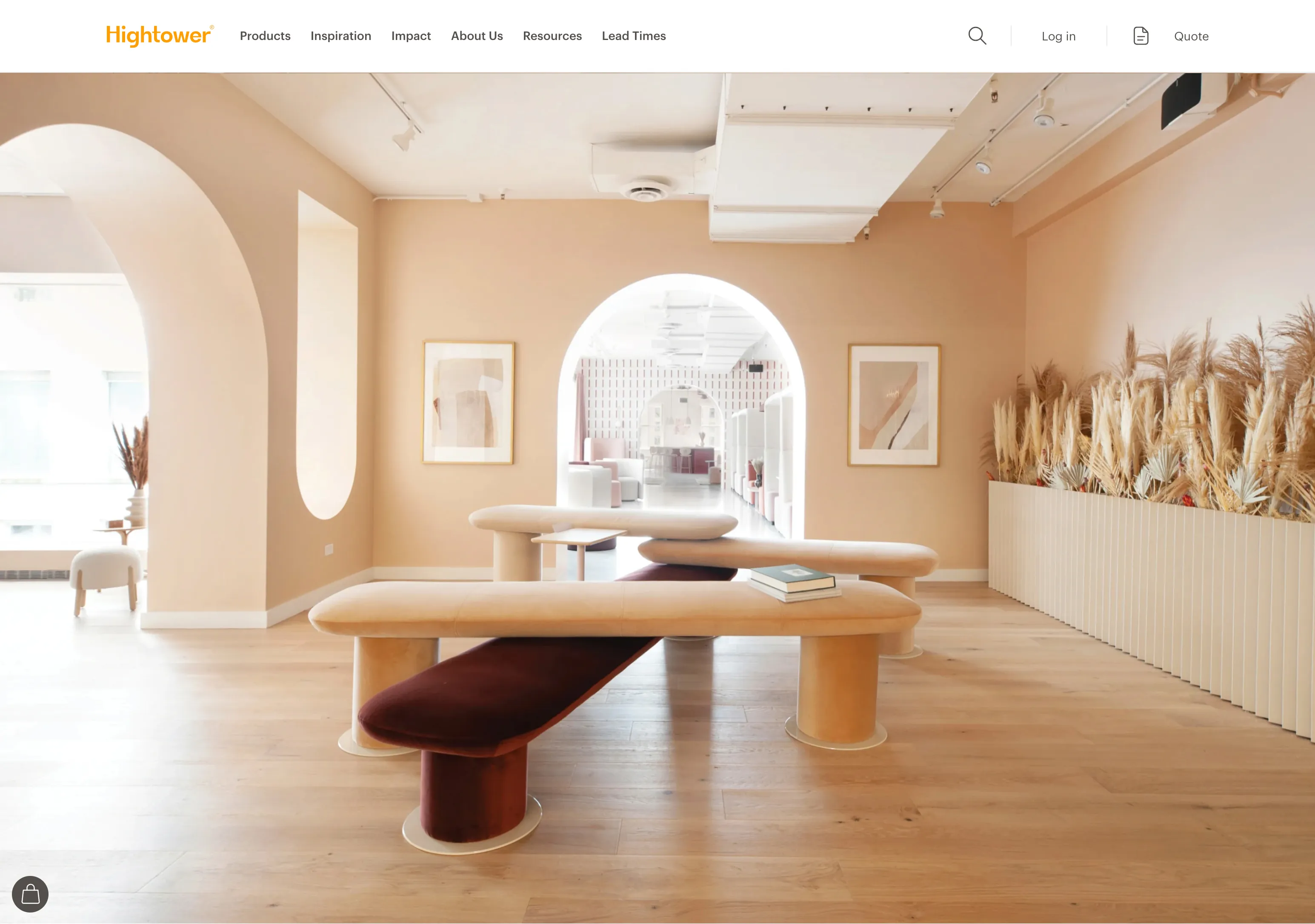| The project | |
|---|---|
| Client: | Hightower |
| Industry: | Interior design |
| Solution: | Shopify Plus |
| Year: | 2023 |
| Visit the Website | |
| What we did |
|---|
| Project Definition, Design, Development |
| UX: Wireframes, Design |
| UI: B2B Store design |
| Shopify Plus: Custom App for B2B |
TL;DR(?)
Hightower, a women-owned B2B furniture brand, needed a scalable Shopify Plus solution to enhance their digital presence. Bluedge USA revamped their online catalog into a fully integrated e-commerce platform, improving user experience, operational efficiency, and quote requests.
The result? A seamless digital transformation that positioned Hightower for long-term growth in the competitive B2B market.
Key Achievements:
- ✅ Custom Shopify Plus implementation for a better B2B experience
- ✅ Enhanced UX & streamlined operations with system integrations
- ✅ Scalable e-commerce infrastructure for future expansion
About the Hightower company
Hightower is a family-founded and women-owned design-forward furniture company for the ancillary spaces where people work, learn, and socialize (think: lobbies, cafes, and lounges).
A Certified B Corporation, Hightower focuses on more than just contemporary, award-winning products for its B2B customers (primarily designers and dealers)—it also prioritizes purpose, people, and the planet.
Jessica Ahlering, Hightower's director of revenue operations, brings together the sales, marketing, client services, and data teams to ensure they are all functioning closely together and well so we can make sure we drive as much revenue for the business as possible.
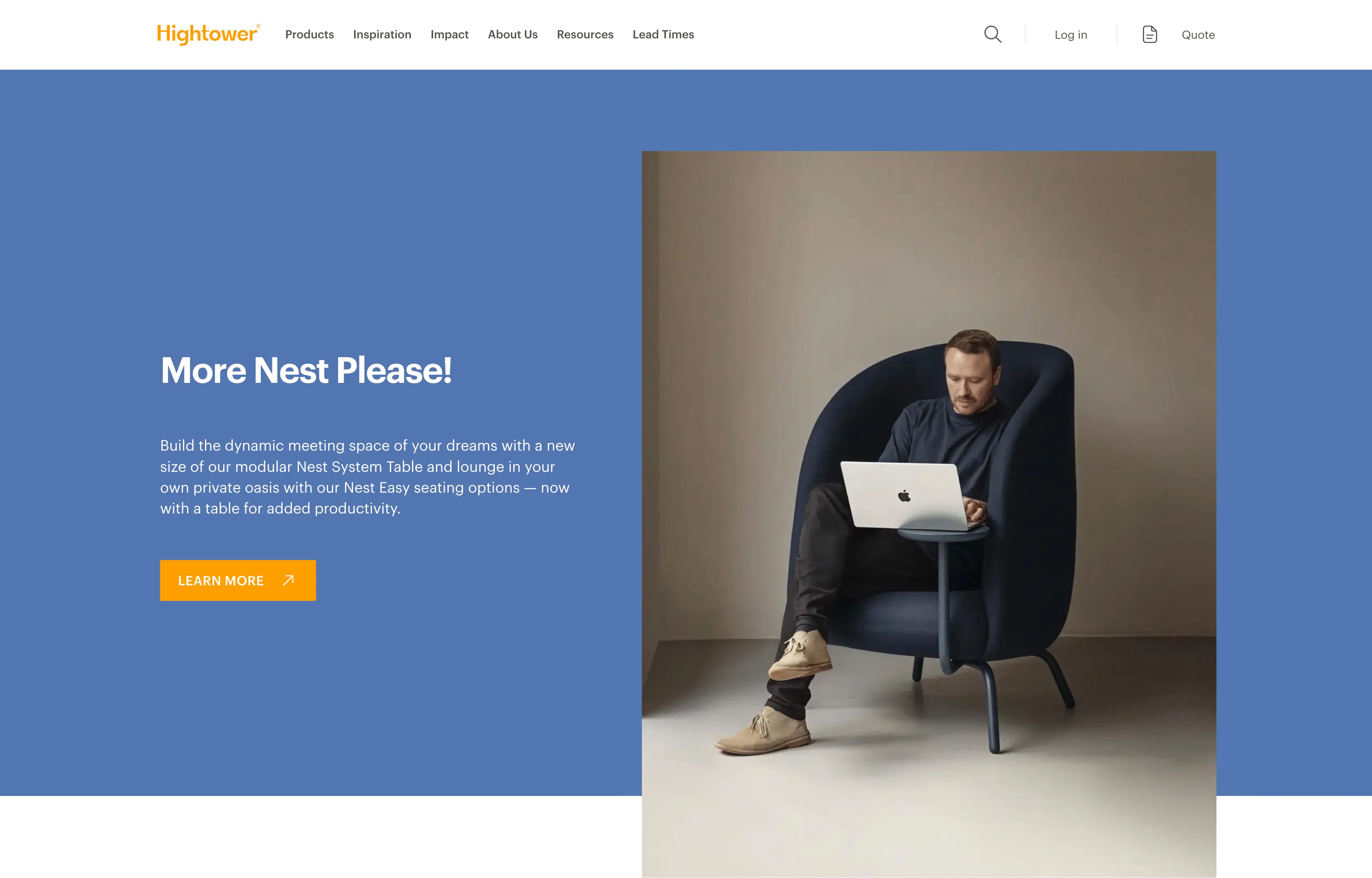
The limitation of B2B ecommerce platforms
Ahlering knew Hightower needed a modern B2B website experience for its highly customizable products.
Our previous website was very limited—it functioned mostly as a digital catalog, she notes. It was important to us to evolve digitally, unlock more data and insights, and lay the foundation for a dynamic e-commerce experience.
Moreover, our product is quite complex and our previous experience had multiple layers that complicated even the simplest updates.
Hightower required a state-of-the-art B2B solution, and more than that, it needed both third-party tech support and internal management capabilities (read: peace of mind) if anything broke or the team needed to make a change—and everything needed to work together.
Hightower's business relied heavily on a high-touch customer service experience, in which every transaction happened through a salesperson. The company believed there was an opportunity to simplify and streamline some of the customer journey through an improved website design.
I saw Shopify held an opportunity to reduce unnecessary person-to-person contact but wasn't sure where to start—or what its limitations were.

Finding a Shopify partner in Bluedge USA
Ahlering approached Bluedge USA after noting its deep Shopify history and experience building one-of-a-kind websites for other companies' customizable products.
We knew Bluedge would de-risk us from a tech support perspective, and on a platform where we knew somebody else was going to be continuing to evolve the technology, the tools, and the resources so that we could grow into that as opposed to needing to custom-plug in things over time, says Ahlering.
From Bluedge's perspective? Hightower had a vision and did their homework—they were ready to do what it takes to get a truly excellent outcome, remembers Nico Alessandra, Bluedge USA's founder.
Ahlering's vision was making the process 80 percent self-service, but seamlessly getting the customer to a high-touch person-to-person experience when necessary.
Hightower and Bluedge got to work on a yearlong project to migration to Shopify, restructuring and redesigning the customer-facing website, ensuring alignment with both Shopify and internal constraints.
Working with the ERP team
But there was more. Hightower not only needed an external-facing website but also a new internal product information management (PIM) system.
Bluedge USA worked closely with the third-party engineers to ensure alignment.
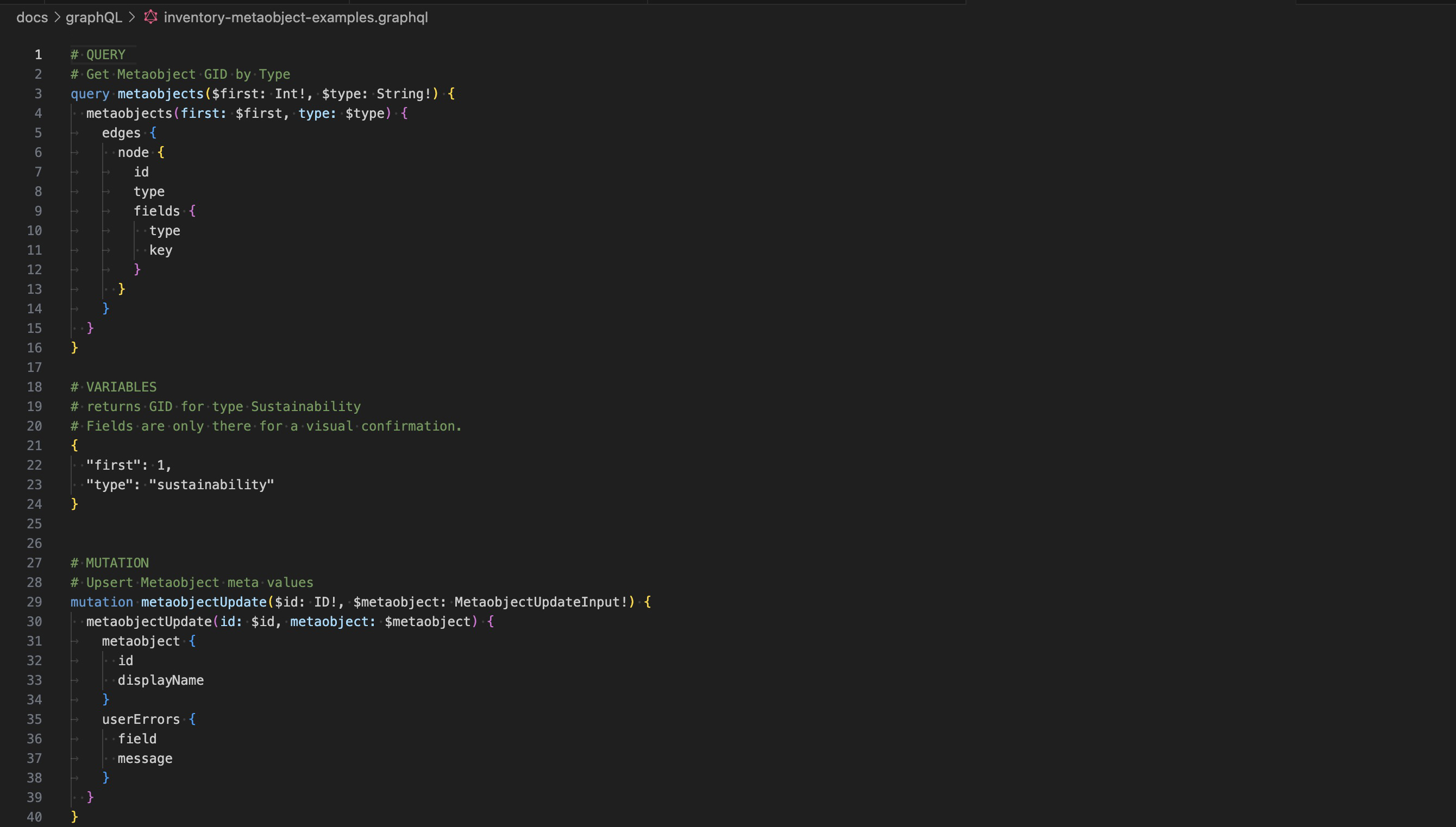
We communicated a clear picture of the Shopify inventory features and limitations and ensure everyone's effort was going in the same direction from day one, says Nico.
Bluedge then created technical documentation with real code examples for to illustrate how interact directly with the GraphQl Shopify API, allowing them to create, edit, and delete products, variants, and metadata for the inventory.
The Shopify website and internal PIM system both fully integrated with Netsuite so that we could have a streamlined, single-source-of-truth experience that would massively reduce the amount of manual work and effort the team had to do, notes Ahlering.
First up: Wireframing
Bluedge USA's comprehensive approach to e-commerce projects always starts with a wireframe.
To develop wireframes, Bluedge met with Hightower teams to define business objectives and the ideal customer experience, then created a bare-bones blueprint of what the site could look like.
Due to the complexity of Hightower's needs, Nico and his team systematically crafted an extensive array of mobile and desktop wireframes that intricately defined each page's functionality and features.
This process ensured stakeholders from departments across the company had time to state their needs, give feedback, and understand exactly how things would work upon completion.
During this first step, Bluedge USA also created a detailed scope of work and project timeline.
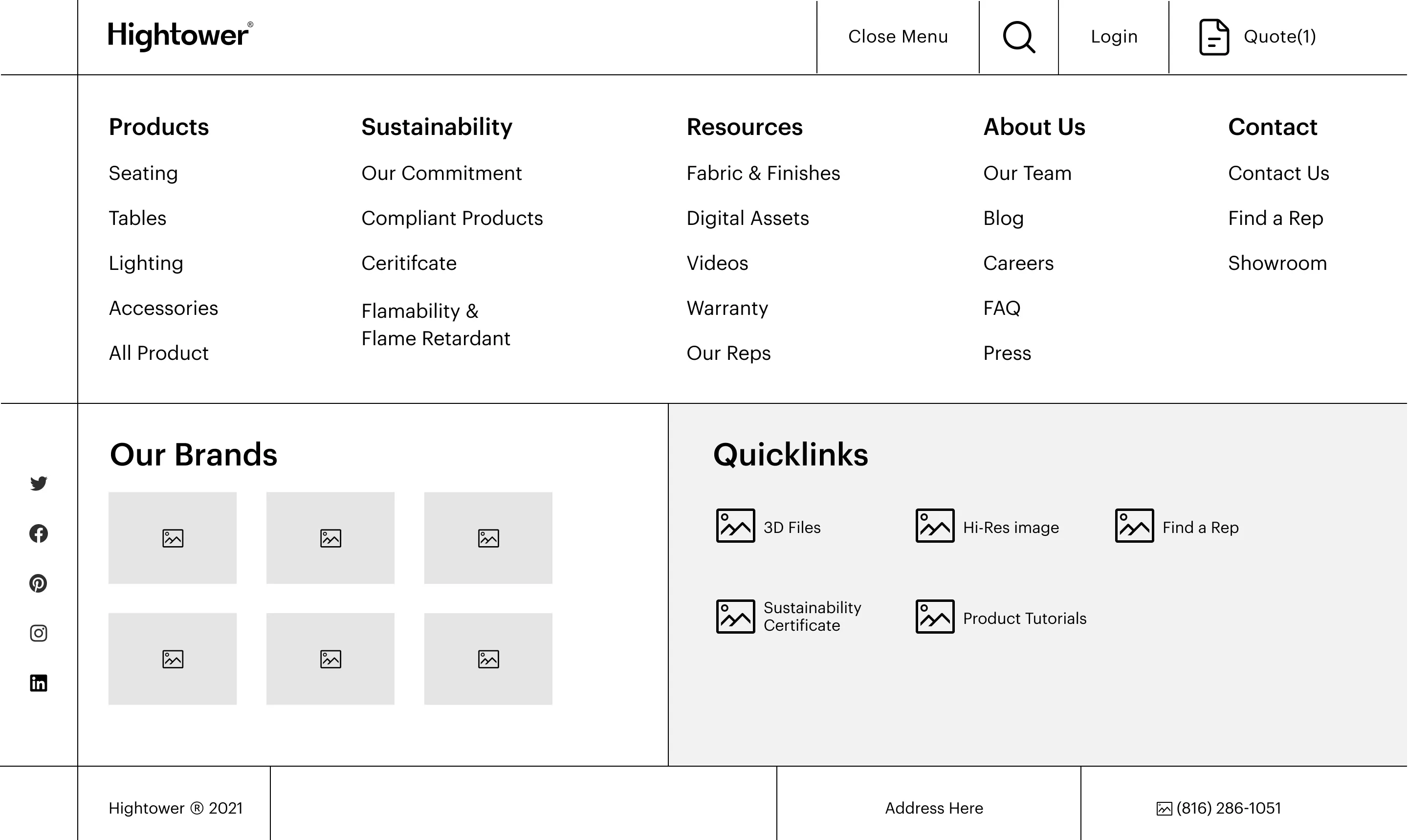
Next, design and development
Bluedge USA's second step is working on a design that not only integrates the features that matter most to a company but also looks good.
The Bluedge team evolved Hightower's already well-loved brand identity to craft a realistic mobile and desktop user experience (UX) and user interface (UI), tapping into the familiarity of a traditional e-commerce website and translating the complexities of the B2B world into a user-friendly B2C format.
E-commerce was born in 1997—everyone has purchased something online. We decided to keep the same spirit, keeping everything as simple as possible for the B2B end user, says Nico.
Once designs are approved, development begins on a blazing-fast Shopify store, the primary goal being to convert visitors to customers.
Here's how Bluedge's e-commerce experts produced a truly next-level B2B e-commerce experience for Hightower's designer and dealer customers.
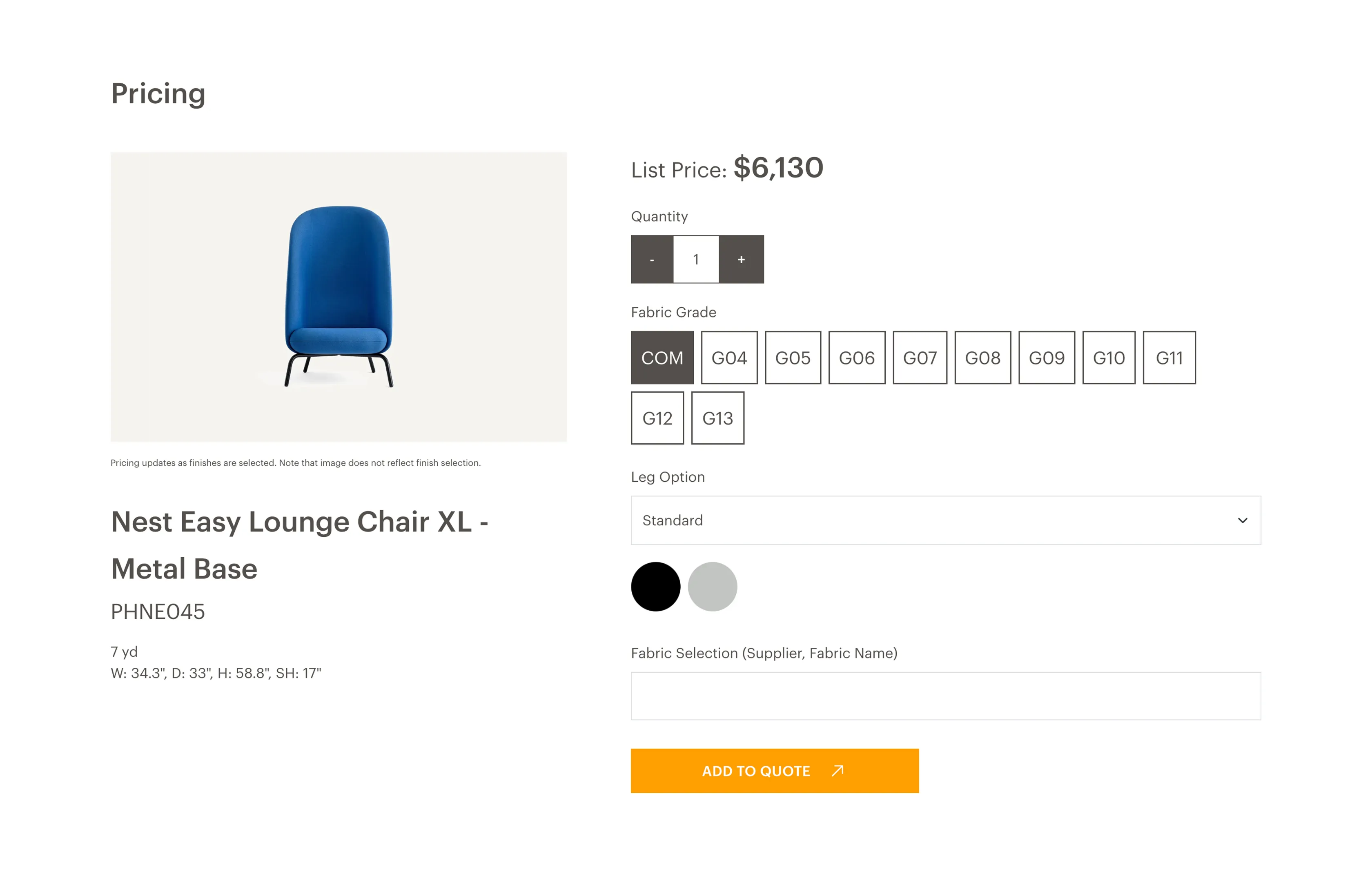
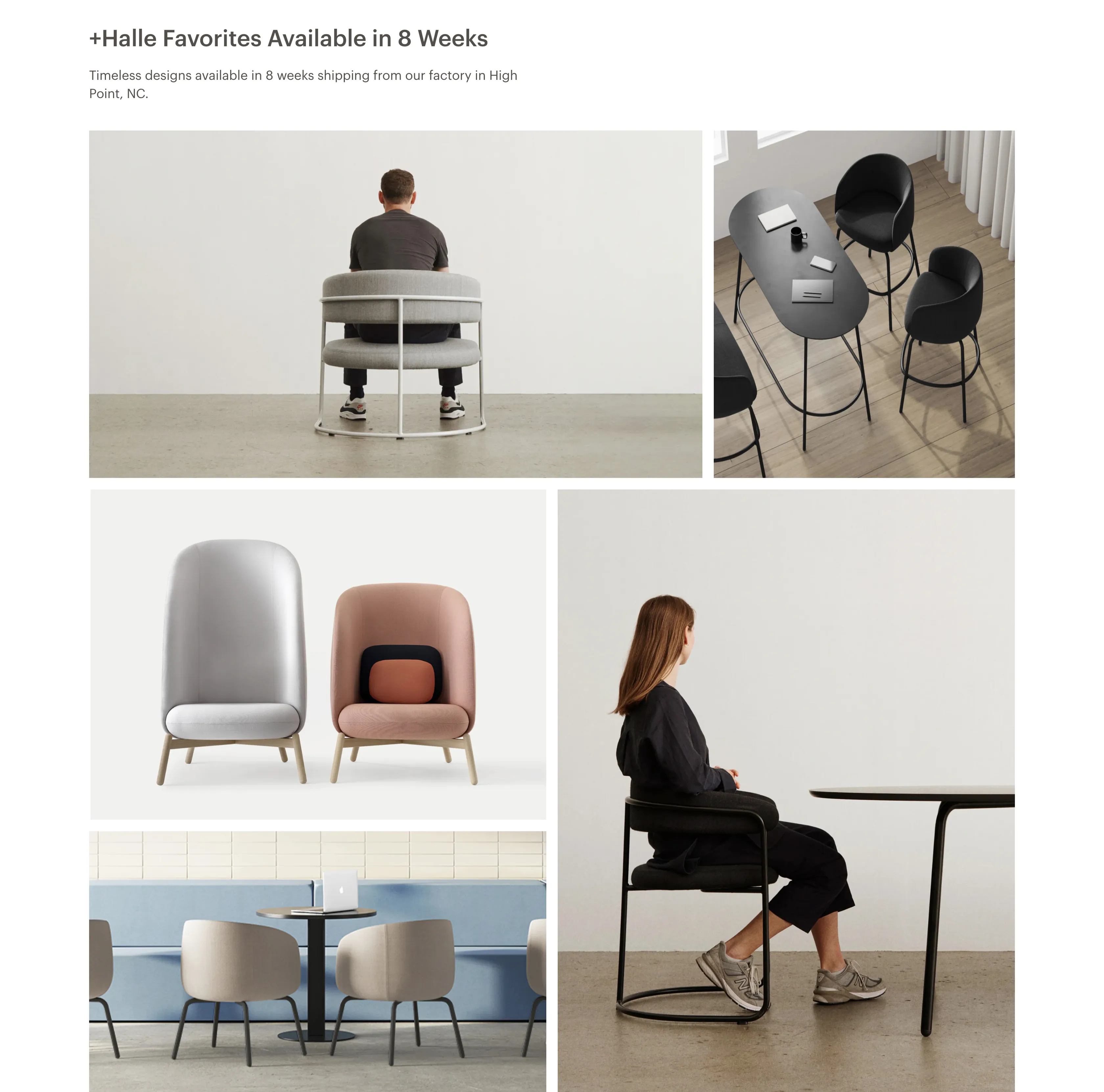
Using a Shopify Custom App for a new quote request process
To create a lower-touch B2B "shopping" experience, Bluedge harnessed the capabilities of a Shopify Custom App that seamlessly combined the flexibility of a private server with AWS services.
Developing a Shopify Custom App was the obvious and secure choice, says Nico, to collect a customer's unique project information and send it to both Netsuite and the Hightower project managers. This type of development also ensures future possibilities for new features as new needs arise for Hightower.
The new quote request process allowed customers to browse robust category and product pages with the ability to customize their order on-page and add things to a quote (Bluedge used an easily recognizable drawer cart mechanism for this).
Customers could also intuitively visualize their quote history and project data details in the cart, mirroring the familiar experience of checking orders on any standard e-commerce website.
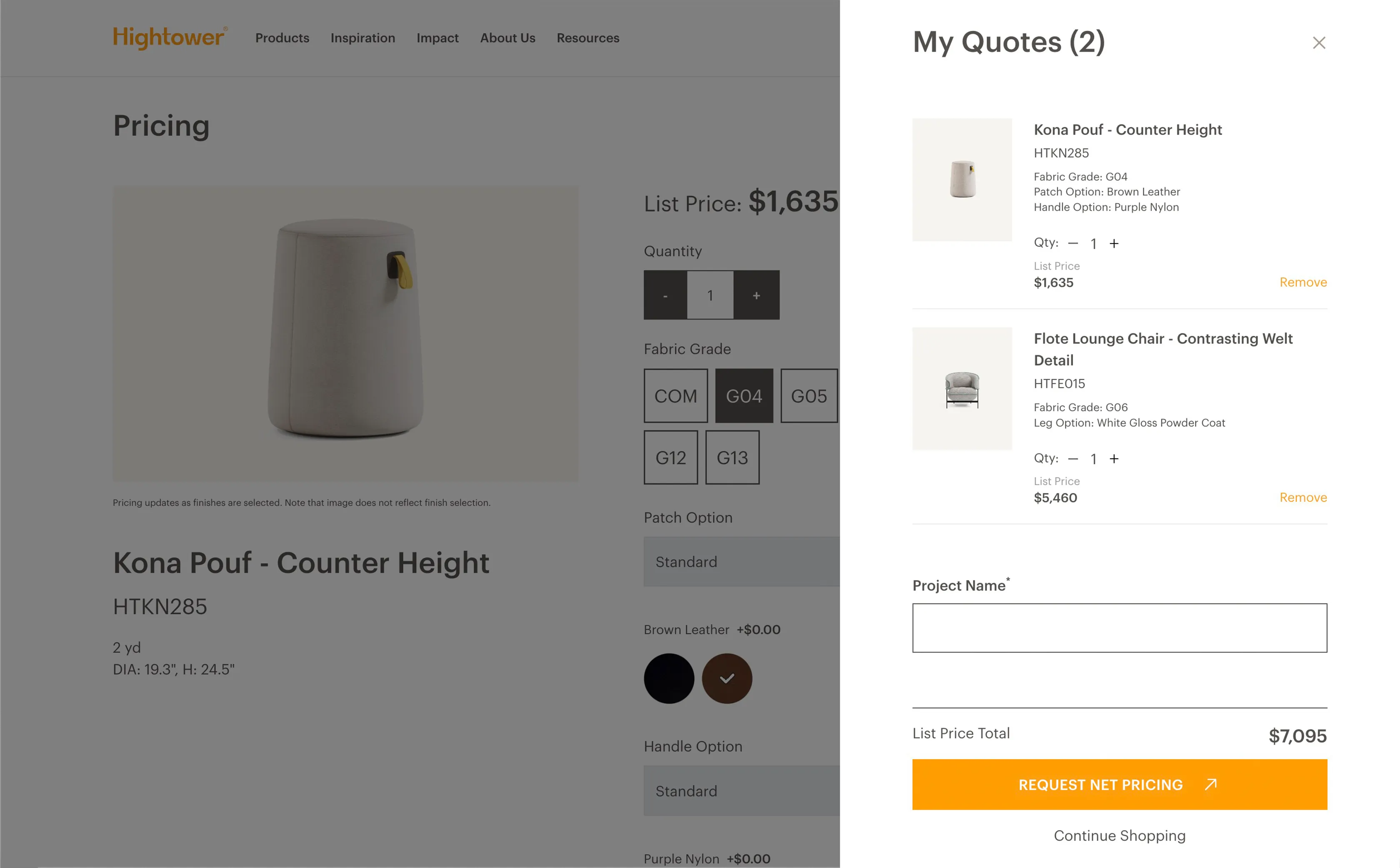
The last thing you want when it comes to online experience is friction, and we were able to make everything happen from the drawer cart, notes Nico.
The information collected in the quotes is vital for Hightower's project managers, who receive detailed emails (while customers receive an email confirmation), enhancing both communication and user experience. The process is also designed to auto-populate orders into Netsuite, reducing the customer service team's manual work.
The new process allows somebody to self-serve. They can shop like they're used to doing on Amazon, but also get the same level of service from us they would've gotten before, states Ahlering.
Into the detail (pages) with Shopify metafields and metadata
Bluedge fleshed out Hightower's product detail pages using metafields and metadata, going beyond Shopify Variants' limitations.
Product details like dimensions, shipping, warranty, upholstery, and videos were added to the pages and, along with inventory, were integrated with AltSource's PIM system.
The recent metadata and metaobject features from Shopify help us push the limits and share data like text, tech specs, PDFs, files, and images across different pages of the online store, says Nico.
To further lean into the e-commerce experience, an "In the Wild" PDP section was born, which showcases real-life photos of the product for customers to understand and visualize it in different settings.
We tried to take things we were seeing in traditional residential furniture retailers that we know people are getting comfortable with from a consumer shopping experience, says Ahlering.
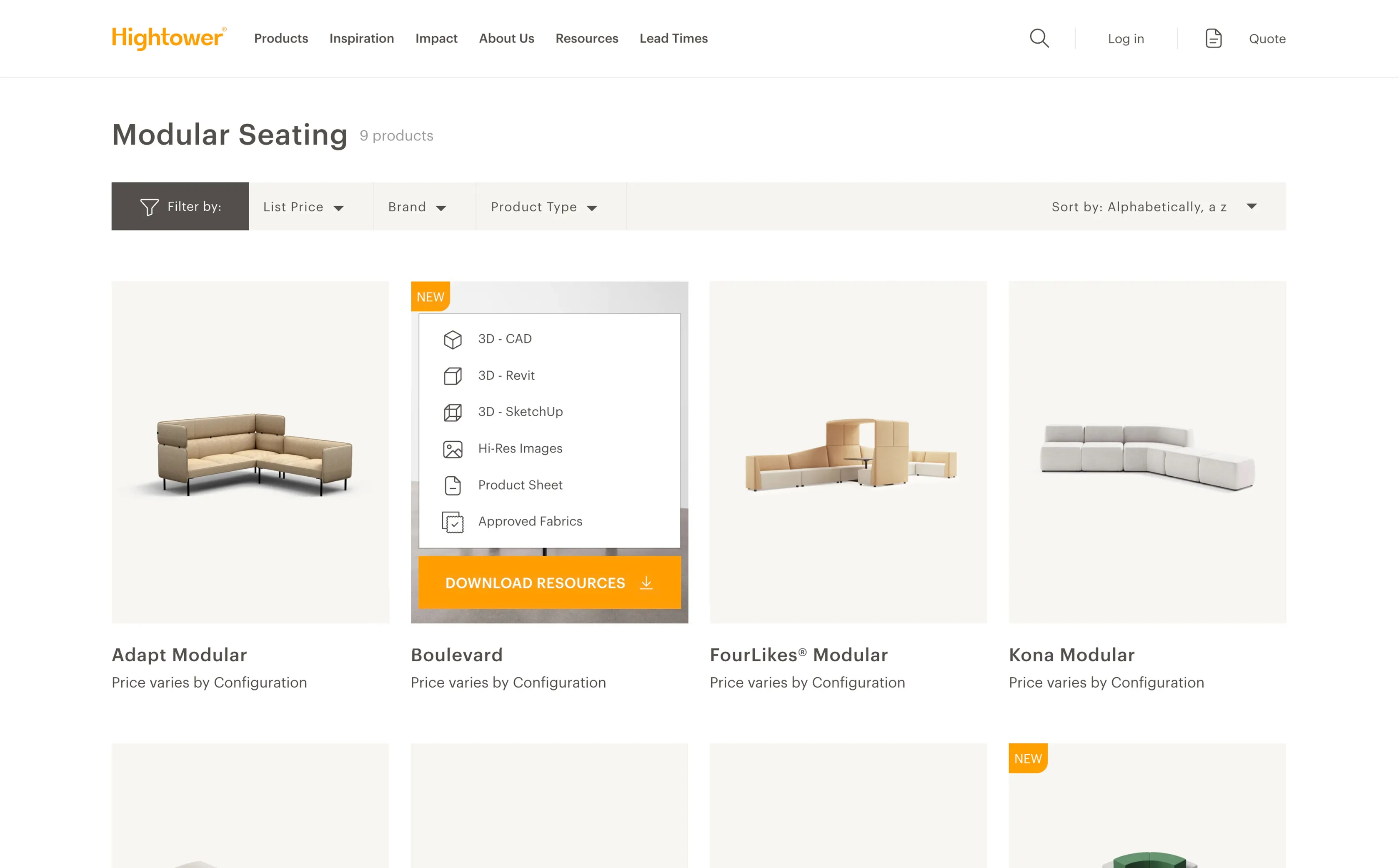

Adding in dynamic pricing with a Shopify store
Hightower was already making a controversial move by putting pricing at the forefront of its site, but Bluedge took it a step further with the new custom Shopify theme.
Bluedge created an interactive experience where customers can select what they want and it auto-calculates it for them so they don't have to do it manually, Ahlering raves.
Customers can now select the specifications they're looking for (like dimensions, upholstery, and finishes) and see exactly how much the product will cost at the list price.
Category customizations
On traditional e-commerce shopping category pages, customers are well-versed in "Quick Shop" buttons that allow them to add something directly to their cart.
To meet the Hightower customer's needs, Bluedge developed a "Download Resources" feature for a quicker look at information also available on the PDP.
The feature lets designers directly access the information they're looking for (like design files, high-res images, product sheets, and approved fabrics) without the need for multiple clicks.
We're getting a designer the tools and resources they need as quickly as possible as they're inspiration shopping, notes Ahlering.
The team also added advanced filters for customers to hone in on results more easily plus a rollover feature that allows you to view a different image of the product when hovering over it.
We're trying to give them as much visual cue and visual storytelling as possible, says Ahlering.
Complex modular products using the Shopify platform to its fullest
Unlike the basic customization of home furniture (do you want a left- or right-facing sectional?), some of Hightower's products are modular and robustly customizable.
To make these simpler to navigate, Bluedge designed a modular product section with up to nine thought-starter designs (Hightower knew customers often order straight from the inspiration options).
Bluedge USA then tied the inspiration configurations to the products associated with them in Hightower's Shopify inventory. Upon building a quote with the modular product, both the customer and the Hightower team can see all the child parts that create this parent product.
They then get brought to a Hightower customer service associate to complete their order.
This solution married the complete freedom a customer could have with all of the options while also leveraging the design, the technology, and the data infrastructure that we had created for the site. So it was a nice interim solution that we were really proud of, says Ahlering.
Advanced Shopify content pages
Bluedge USA also ensured the rest of the site's content was organized, easily navigable, and interconnected.
Shopify Backend Blocks and Sections were used to create a custom navigation mega-menu and fleshed-out content pages to expand on Hightower product education.
Those content pages included a Designer page with filters that linked back to specific products so customers could see designer information fetched from that content page on each PDP.
On pages with large images and banners, a "Shop the Look" button was created to link to relevant products, and for content with many layers, Shopify Custom Filters were added to help organize.
Across the site, it's now easier to contact a customer service representative, with multiple pages containing contextual links to a custom form that goes directly to Hightower's project managers.
Our Custom Shopify theme is flexible while making sure it stays on brand. Most page sections can be reused on different pages with different content, says Nico of how Bluedge gave Hightower the best technical options in the backend of Shopify while keeping things realistic and easy to use.
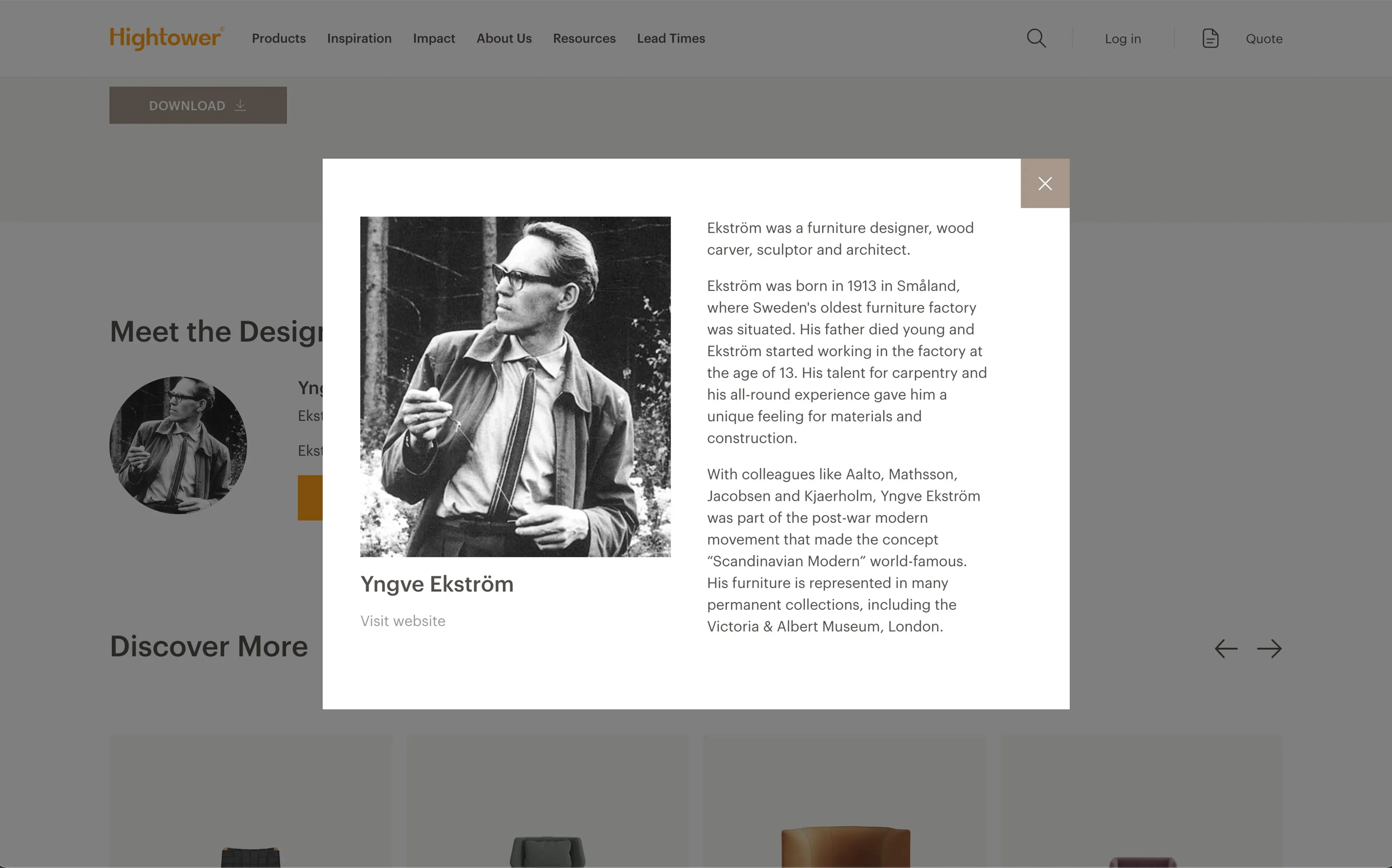
Seeing the change and moving forward
After performing quality control (on the design, features, speed, SEO, and ADA compliance) and training Hightower on the new system, the site was finally live.
Ahlering raves that her team can now understand Hightower customers' behavior throughout their shopping journey and therefore better solve their needs along the way—including being able to give them a new self-service experience while providing the full-service experience at all the right moments.
Plus, Hightower has full autonomy to change things on its own and the support of a tech team to keep it going.
We have weekly if not daily relationships with most of our clients. Online B2B retail is a very dynamic industry, so we answer questions, discuss new projects, and help Hightower grow their online business with new ideas and concepts, explains Nico. Offering constant consulting to our clients is a big part of what makes our job so interesting day after day.
Bluedge has given us the space and freedom to run so that I don't have to call Nico whenever I want to make a small change on the website. That freedom has been probably the biggest relief and one of the most exciting things for our team.
Jessica Ahlering
